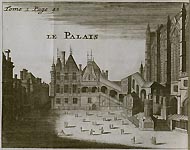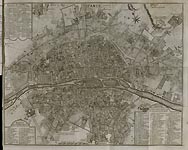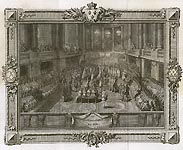Bourbons and the Royal Library
Henry IV
After the death of the last Valois, Henry III, who was slaughtered by the Dominican Jean Clement in 1589, the only legitimate heir to the French throne was the King of Navarre, Henry de Bourbon. Henry III left no male descendants and had no close male relatives. The Bourbon family, that originated at the late 13th century as the cadet branch of the Capetian dynasty, received the rights to the French crown. France, which was torn by religious strife, refused to recognize him as king for a long time, because Henry openly sympathized with the Protestants. Only in 1594, after the public renunciation of Calvinism and multiple ingenious negotiations with the nobility, Henry IV was crowned in Chartres Cathedral and solemnly entered Paris.As a legacy from his predecessor, he inherited not only a devastated, blood-stained country, a devastated economy and the deserted Louvre palace, but also the true gem of the last Valois — their library. Books, brought by Charles VIII and Loui XII from Pavia during the the 16th century Italian wars, formed the basis of the library. It was originally kept in the royal residence in Blois, and under Francis I was transferred to the newly built Fontainebleau castle. In 1593, Henry IV appointed his friend and faithful associate Jacques-Auguste de Thou the custodian of this small but valuable collection of books and manuscripts.
The historian and writer Jacques-Auguste de Thou was well educated person and a competent bibliophile. He was able to treat the treasure entrusted to him. First of all, he inspired the king to carry the library from Fontainebleau to Paris, because the old guardian, the astronomer Jean Gosselin already barely coped with their duties. At that time, the Jesuit Clermont College building was vacated in the capital, one of its students, Jean Chatel, attacked the king with a knife during his visit in December 1594. He was then executed by dismemberment, the Jesuit Order was banned from France, all their property was confiscated in favor of the Crown. The Clermont College was closed, and the building housed the royal library, which then numbered just over 20,000 volumes.
In the same year, Jacques-Auguste de Thou acquired for the King the books of the deceased Catherine de 'Medici, the mother of the last kings of the Valois dynasty and Henry's mother-in-law, IV (her daughter Margarita, the famous "Queen Margot", was the first wife of Henry of Navarre). In 1589, the queen-mother died and left huge debts, her library was bought from the auction through the efforts of de Thou.
Jacques-Auguste de Thou continued to engage in administrative and political activities, spent most of his free time writing historical works and could not fully devote himself to the care of Henry IV's books - , so after the death of Jean Gosselin in 1604, he invited the well-known classical scholar, philologist and erudite Isaac de Casaubon to become the curator of the library.
Even before the appointment of Casaubon in 1603, the Jesuits obtained permission to return to France and received their property back. The Capuchin brothers agreed to host the library. The royal books were stacked in the large hall of their monastery in La Garp Street. Henry IV wanted to build a college of France with a special room for the library and make it the scientific and educational center of the kingdom. He even charged J.-O. de Thou and his advisers with the duty of drawing up a project, but on 14 May 1610, the tutor François Ravallac jumped on the bandwagon of the royal carriage and murdered King Henry of France. The plans of the deceased sovereign remained unrealized, and the Cordelier monastery in Paris became a refuge for the royal library for almost sixty years.
Louis XIII
After the assassination of Henry IV, many Protestants felt themselves in danger: the old king, despite his formal renunciation of Calvinism, was distinguished by religious tolerance and a pragmatic attitude towards the people who served him. This could not be said about Maria de 'Medici who came to power as an appointed regent over the underage Louis XIII. The Queen immediately broke those fragile arrangements that allowed her wise husband to become a sovereign. As a result, representatives of the higher nobility led by Prince Conde raised an uprising, and Protestants fled the country.
Among them was Isaac de Casaubon. He retired to England at the invitation of King James I, where he died in 1614, keeping not only the honorary title of curator of the library of the French king, but also receiving a solid pension. His responsibilities passed to the graduate of the Clermont College Nicolas Rigot, the Latinist and translator of Greek texts, who held this position for the next twenty years.
After Louis reached the age of majority, the library was moved to the hall on the street La Garp near the church of St. Cosmas and St. Damian, where it remained for the next forty years. At that time, it became officially called the "Royal Library" (Bibliothèque du Roi).
Although Louis XIII inherited a love of books from his mother (even there is a legend that he himself bound his books). During his rule, the Royal Library was hidden and almost forgotten place, although it was carefully guarded. The young king transferred many affairs of state to his first minister, Cardinal Richelieu, who conducted them brilliantly, receiving countless riches for his service. He can be credited with founding the Royal Printing House and the French Academy, but the Royal Library is not lucky in this sense. The cardinal himself was a keen bibliophile and collected his private library, so he replenished it with books that were sent to the king by foreign sovereigns or captured during military campaigns.
However, one day, Louis XIII recalled his library and intended to return it back to the Palace of Fontainebleau, where, it seemed to him, it would be more accessible. But the practical realization of the sovereign's desires lay on the all-powerful Richelieu, this idea was implemented in very specific way. Abel de Saint Martes, a lawyer close to the Minister, was appointed "custodian of the Royal Library in Fontainebleau", but the books were not transported there. After "a keeper of a library without books" died, this post was inherited by his son, who was also named Abel. Abel II was a man of honor and, apparently, did not want to put up with sinecure. In 1668, he wrote a petition to the king Louis XIV with a request to restore the library in Fontainebleau. The petition remained unanswered, but after the death of Abel II in 1706, the post was abolished.
In 1642, the post of the guardian was taken by Pierre Dupuy, and, after his death in 1651, by his brother Jacques. Their cousin Jerome Bignon was appointed the administrator. All three had brilliant education, personally communicated and corresponded with the best minds of their time: Hugo Grotius, Joseph Scaliger, Daniel Heinsius, Jacques Sirmon, Pierre Gassendi. The heads of the library supported the ideas of Gallicanism, which led to the penetration intellectual free-thinking and secularism into the institution entrusted to them. . & nbsp; Bignon and the Dupuy brothers privately invited scholars to work with books, but, despite all their efforts, the library did not become the intellectual center of France. This happened a little later, during the reign of Louis XIV, the Sun King, for whom the Royal Library would become one of the symbols of absolute power.
Cardinal Richelieu died in 1642, Louis XIII survived him for no more than a year. The five-year-old Louis XIV took the throne.
Louis XIV
The period of childhood of the king again became a shock for France and a trial for the Royal lLibrary. During the Fronde, a series of civil wars in France between 1648 and 1653, no one paid attention to the royal book collection, and the library was almost forgotten. This oblivion continued for many years after the end of the Fronde: like Richelieu, the new first minister Cardinal Mazarin collected his own library which was located in his magnificent palace and became in fact the first public library in Paris during the life of the cardinal. An example of the neglect of Louis XIV to the library is the appointment of Nicolas Colbert, close to Mazarin, its custodian in 1656. As early as 1661, having received the bishop's department in Luzon, Nicolas Colbert left Paris forever, but kept this position until his death.In 1661, Mazarin died, and Louis XIV took over the power. He almost immediately began building his new country residence in Versailles, wanting to leave the Louvre as soon as possible, because it seemed to him an unsafe place to live after Fronda. The young king showed no interest in books, never valued them and did not collect them, and yet a great number of books with his super-ex-librises have survived, including those kept in the National Library of Russia. The paradox has a historical explanation: henceforth, the King’s books became a manifestation of royal power, they ceased to be an expression of the bibliophilic hobbies of a particular sovereign.
For the first time, the idea that the King’s library should be a simbol of the monarch’s unlimited power came to Jean-Baptiste Colbert), Minister of Finance Louis XIV, who was actually the chief architect of French absolutism and breathed life into the neglected book depository. Jean-Baptiste Colbert started his service to Louis XIV with a large-scale anti-corruption campaign. Many embezzlers were put on trial, and their property confiscated. Colbert's biggest victim was the former superintendent of finance and the general prosecutor Nicolas Fouquet who became famous not only for his luxury, and insatiable greed, but also for his impressive library. Perhaps it was in 1664 when Colbert transferred the books of convict Fouquet to the King’s library, his imagination was struck by the sight of a huge but unclaimed book depository.
However, at this time the Royal Library was replenished not only due to confiscations: in 1660, Louis XIV inherited the art collection of his uncle Gaston de Orleans. For all his life, this grandee was a fine connoisseur of art, he gathered an excellent library, first in the Luxembourg Palace in Paris, and then in his castle in Blois.
In 1666, J.-B. Colbert transferred the Royal Library from the small monastic building to his chambers on Vivienne Street. At this time, the library was not yet the largest and richest in France; many private book collections were much more extensive. To buy new books, Colbert sent agents across Europe and Asia. He was able to poach the leading intellectuals of his time into the Royal Library from the libraries of Richelieu, Mazarin, Fouquet and Colbert himself.
After the death of Cardinal Mazarin, J.-B. Colbert was one of the executors of his will, which allowed him to make an unequal exchange of doublets from the King’s library for unique manuscripts and publications from the Mazarin’s library. In 1676, the library keeper Nicolas Colbert died. His post was transferred to J.-B. Colbert's son Louis.
In 1681, the efforts of J.-B. Colbert on the development of the Royal Library were rewarded: Louis XIV honored the library on Vivienne Street with his visit. The Sun King, who constantly lived in Versailles, visited it only once, but his visit was more eloquent than any praise: all subsequent French monarchs from the Bourbon dynasty were never in their library.
In 1683, J.-B. Colbert died. The new superintendent of the royal buildings was his longtime enemy François-Michel Le Tellier, marquis de Louvois, who immediately succeeded in dismissing Louis Colbert and Jerome Bignon and transferring their posts to his eight year old son Camille Le Tellier de Louvois.
Camille received a brilliant education and become a worthy successor to his predecessors. Le Tellier continued the practice of buying books abroad. Following the way of development of the large book storages, the young librarian opened a reading room for scholars and allowed all the curious to visit it twice a week (although, at that time, the public library was the Mazarin library). Im 1718, Le Tellier died while still he was a young man. In 1719, the king's librarian finally became abbot Jean-Paul Bignon.
Louis XV
J.-P. Bignon united the functions of the administrator and custodian of the Royal Library in his hands. In addition, since 1720, he received books stored in the Louvre Palace in his management. A talented administrator, J.-P. Bignon reorganized the book depository: the library was divided into divisions: a depot of printed books, a study of manuscripts, an office of documents and genealogies, an office of engravings and a collection of prints, an office of medals and engraved stone slabs, where statues, vases, plates with inscriptions were kept. A keeper with a staff of assistants was placed at the head of each unit. However, the main problem of the Royal Library was the building on Vivienne Street, which not only became cramped for such a huge collection, but also decayed.A new place for the library, which numbered 70 thousand books, was soon found. After the collapse of the French Indian company, the space occupied by it was vacated in the old palace of Mazarin. This is where the royal book depository was housed in the first half of the 1730s.
In 1735, the Royal Library opened its doors in the new building to the public. The era of the Enlightenment began: the flow of readers to the library grew day by day: scientists, artists, collectors came here. Every day the library was open for three hours, and it continued to let ordinary curious people in it twice a week. From time to time, the Royal Library was visited by French princes and foreign sovereigns. The Age of Enlightenment not only increased the general public's interest in books, but radically changed the book production and book trade. There is a significant decrease in the number of published religious books. Scientific and fiction books took their place.
Louis XVI
The 18th century became the heyday of the Royal Library when it turned into one of the largest book collections in Europe and deservedly gained primacy among the public libraries of the time. In 1784, the new king Louis XVI appointed Pierre Lenoir as his librarian.Pierre Lenoir was a native of the Paris Parisian family, received a brilliant legal education. A sincere admirer of the ideas of the Enlightenment and the Encyclopedists, he consistently brought them to life during his impeccable public service, which allowed him to become the head of the Paris police. Ten years later, Lenoir received the position of royal librarian as a reward for faithful service. He did not change his habits in dealing with subordinates, encouraging them to inform on one another. He was rude in communicating with them. At that time, about fifty employees worked in the library, most of whom were intellectuals and prominent scientists who perceived the situation as a personal insult. They launched a public campaign against their boss, accusing him of favoritism, ignorance and an unsuitably luxurious lifestyle. Frightened, Lenoir ceased to appear in the library, and, after taking the Bastille on 14 July 1789, fled to Versailles, retired and soon emigrated.
The new librarian — the eminent Hellenist Louis Le Fèvre d'Ormesson de Noiso he might have written the glorious pages in the history of the great library & mdash; at other times, but in the revolutionary hard times, he had to leave his post in 1792 and, in 1794, end his life on the scaffold. Over the next several months, many librarians changed and almost all of them were put to death with a guillotine.
In 1793, King Louis XVI and his wife Marie-Antoinette were executed, and, in 1795, the revolutionary Convention formally renamed the Royal Library into the National Library of France. The library has not lost its national status and it still retains it.




